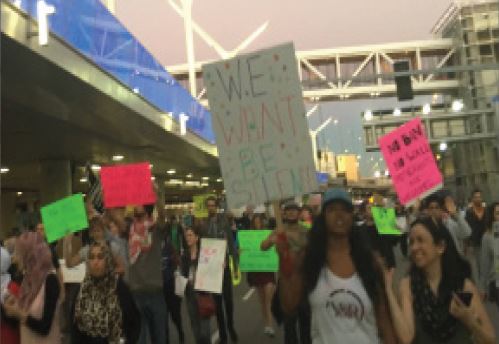Peaceful Protests Are Surprisingly Effective
With the election of America’s newest president, many controversial political issues have developed, and the strong statements that have been made by the president have certainly not tamed any of these concerns. Many marches and protests have occurred since President Donald Trump’s inauguration such as the Women’s Marches, protests against the muslim ban, and the general anti-trump protests all around the country. With these protests and marches stemming in the recent past, many people have begun to oppose these gatherings because they believe they are “meaningless” and “a waste of time.” The idea that marching around for blocks and protesting about important issues is useless has become a common misconception for people against these protests. Protests are actually effective in the way that bring light to situations that people would not think about otherwise.
A protest does not necessarily have to consist of several people marching in the streets, holding up signs, and chanting for change. A protest is considered any statement a person makes to stand up for what the believe in, even if it goes against the law, which in this case would be called a peaceful protest. Peaceful protests are certainly more effective than protests that turn violent, because the latter allow people to stereotype all protesters as “wild and irrational.” Although fighting for rights during a protest can provoke angry and frustrating emotion, it is important that only positive messages are sent out rather than hateful remarks because it gives people room to understand the overall message. According to The Washington Post, from 1900 to 2006, the success rate for peaceful protests was much greater than than the success rate for violent protests. They stated that peaceful protests had a 60% success rate, while violent protests had a 20% success rate.
Overall, marches and protests cause awareness for people who are not familiar with certain issues. Constantly striving for a change motivates others to aim for that same purpose which increases the amount of voices being heard. Marches and protests can be very effective in the long run, but may not have an immediate reaction on its current situation. For example, Rosa Parks held her own peaceful protest by refusing to give up her seat on a public bus, despite the fact she was required by law. The issue became a big controversy and prompted The Montgomery bus boycott. In 1956, a year after Park’s peaceful protest, the Supreme Court ruled that segregation on public transportation was unconstitutional. Although Rosa Parks did not lead a march through the streets to fight for the segregation on buses, she peacefully protested herself and made a statement which furthered the Civil Rights Movement. Another example of an effective peaceful protest is the March on Washington. The rally to promote racial equality in 1963 consisted of over 200,000 people. The historic event led John F. Kennedy to create civil rights legislation which were submitted to Congress for equal access to public facilities, to end the segregation in education, and to provide protection of the right to vote.
Many protests have greatly impacted the change of certain issues. Whether they were immediately effective or not, changes have been made that paved the way for how citizens are living today. It is inaccurate to believe that protests and marches are ineffective because history has shown how effective even the most peaceful of protests can be.
Hello there! Our goal is to provide relavent, engaging journalism for readers of all ages. Your donation will support the student journalists of the Wolfpacket at Claremont High School, and will allow us to purchase equipment, print our monthly issues, and enter in journalism competitions. We appreciate your consideration!

Ivana Estrada is a senior on the Wolfpacket staff as the assistant Sports editor. Estrada has been on staff since her freshman year and hopes to make her...





